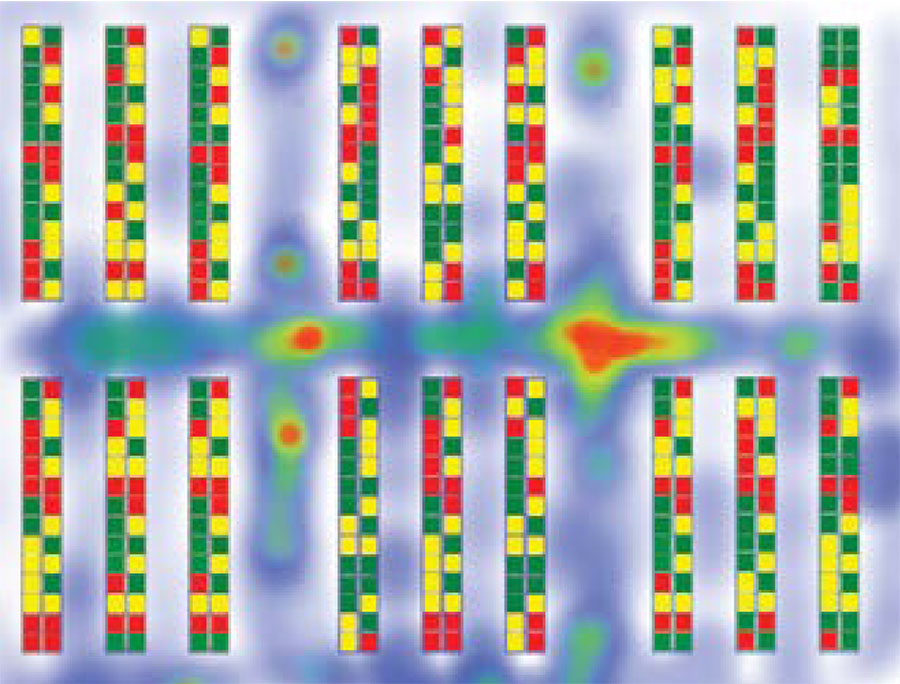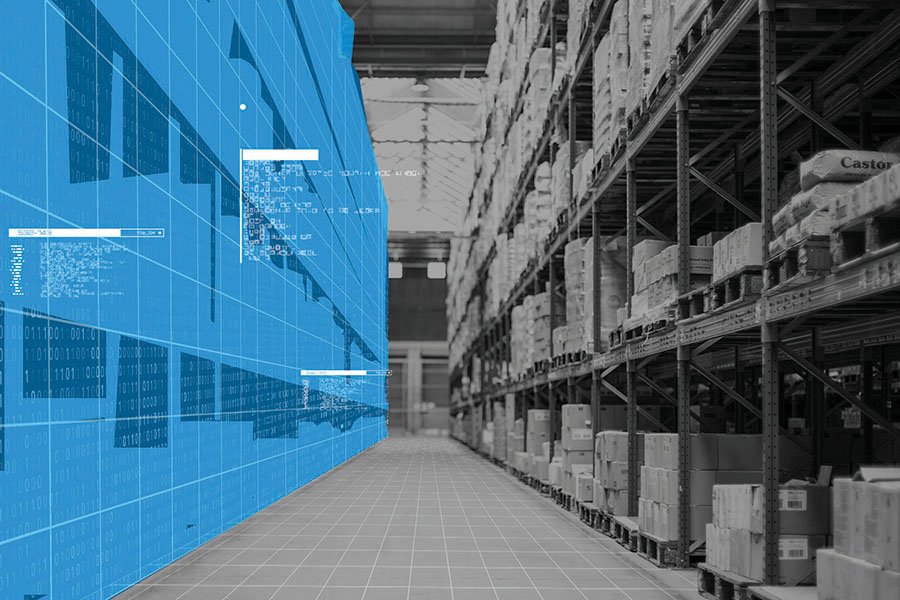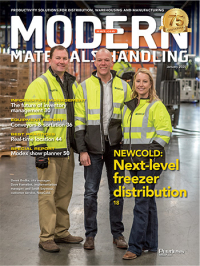Real-time location sees the space between
After decades of steady progress, the industry prepares for a flood of technology to capture and act upon real-time location of assets, people and goods.
Despite being an industry focused on the movement of goods, until very recently, the materials handling industry had flourished using a fairly basic assortment of checkpoints and transactions. Aside from time elapsed, so much of what happened in the movement of goods went unmeasured.
In its efforts to respond to unprecedented consumer demands, the industry has labored under operational holdovers from the days when folks allowed six to eight weeks for delivery. Despite incredible progress, compressing the transactions hasn’t increased visibility of the spaces in between.
A new generation of location-based data analysis tools are working to collect information about the movement of items, employees and assets. The possibilities are tremendous, leading one solution provider to boldly declare that a Holy Grail has been found. But it’s also reminiscent of some 20-year-old claims surrounding RFID. Modern spoke with industry experts to determine how the latest technologies are different, what already works and what might be coming soon.
Building a detailed map
John Hill, director at supply chain strategy and logistics consulting firm St. Onge Co., says, at least conceptually, comprehensive location data is not at all new.
“Now we have the technology,” Hill says. “I love the idea of being able to identify something’s location down to the centimeter. That’s wonderful. But, people assume you can just do it. ‘Why not put a tag on everything, then we can press one button and get an instant update?’ That sounds nice, but what’s the value proposition?”
Cost is always a factor, but not everyone knows what they’re buying. People now take bar code and, to some extent, RFID for granted, Hill says. “It works” the uninitiated think, assuming that an integrator or inventory management supplier will.
“Maybe I’m living under a rock, but I don’t see an appropriate amount of attention paid to the nitty-gritty parts of putting a system together,” Hill says. “A lot of folks with technology like augmented reality, machine learning and robotics come to us to explain what they’re doing. When they start at the high level it’s very intriguing. Then when it gets down to what is available today, and how to start down the path to total integration and total visibility of inventory, the reality is that’s going to take a long time.” But, that doesn’t make the journey any less appealing.
“This is a huge opportunity,” says Mark Wheeler, director of supply chain solutions at Zebra, who says real-time location systems (RTLS) are an idea whose time has come. “Customers are not sure where to start and how fast to move, but the consensus is that there is a lot of value in these technologies.”
Some of the value lies in previously unmeasured metrics. “Once you start to design a system with the assumption you always know where everything is, you can start to imagine leveraging artificial intelligence (AI) and machine learning to optimize the things we can’t now,” says Wheeler, who adds that the process of navigating an entire new data stream will take time. “A lot of the focus is on being able to work alongside existing systems until they begin to adopt this sort of data into their core processes.”
Wheeler suggests we are in a long-term migration from the way we’ve always done things in the warehouse, which had been stable for 35 years.
“I call it ‘scan and hope.’ Operators scan and you hope they did what they say they did, but you’re constantly verifying that tasks have been competed properly,” he says.
Instead, Wheeler suggests a company might work with suppliers to ensure all incoming material is tagged at the pallet and case level. RTLS area readers for passive UHF use very inexpensive single-use tags and expand locationing to actual materials. Each reader covers 1,500 square feet and can not only detect but locate. When materials arrive, the system instantly knows it’s here and where.
“Instead of managing by ‘scan and hope,’ you can set up a series of zones and alerts, creating rules in the system,” Wheeler says. “If product is supposed to be in the freezer, you can measure how long it has been in ambient temperatures and prioritize it. Those kinds of things are very doable with the technology we have.”
Existing warehouse management systems (WMS) are not designed to handle that type of information. A lot of WMS solutions can support some task interleaving, but not in real time. Once it sends an operator on a putaway task, if demand pops up for a pick they could execute on the way back, a WMS is probably not going to be able to take advantage of that opportunity, Wheeler says.
Automated manufacturing line reduces tracking costs with RAIN RFID
Founded in 1997, Faurecia has become a global leader in the automotive industry, providing products like seating and interiors from 300 sites employing 122,000 in 37 countries. The company’s products are now in one third of all cars. Since 2015, guided by Industry 4.0 principles, a strategic initiative focused on the digital transformation of manufacturing operations has optimized production lines at 12 plants using RAIN RFID (Impinj). The solution helped the company improve operations; increase efficiency in parts stocking; reduce manual tasks in shipping, receiving and transferring; and increase customer satisfaction.
The solution provides real-time visibility of inventory by tagging items that enter the plant and installing readers along the manufacturing line. This optimizes logistics processes while eliminating redundant manual steps. Tags are attached to each item as they are manufactured, including bags, boxes and finished products. Readers are installed at key transition points such as manufacturing areas and loading dock doors.
“We were able to streamline and automate our manufacturing and shipping processes,” says Emmanuel Schröder, digital transformation project manager for Faurecia, adding that with increased visibility, field workers have a better understanding of the activities on the plant floor and the data needed to make informed decisions about future operations.
By automating tracking of their shipping and receiving operations, Faurecia ensures customer satisfaction with highly accurate information on stocked items and improved parts traceability. The company plans to expand the project to additional plants and warehouses worldwide, and the solution can now be deployed within one week at each new plant.
“Early adopters are looking at the biggest ROI, which is for relatively less-structured environments like receiving and shipping docks,” he adds. “It’s a big change, and it will take time for this to grab hold.”
A two-way street
We tend to think of a device’s function as simple two-way communication, and might even visualize a string connecting a device to a Wi-Fi node. But with a variety of mobile assets pinpointed in motion, the various strings weave a web that communicates much more than coordinates. The combined visibility results in what Vik Pavate, CEO of Locix, calls spatial context.
“Imagine integrating the location of the device doing the scanning, and you discover the WMS comes up with a certain type of allocation by estimating distance,” Pavate says, who adds the only way the WMS can actually understand the operation is when the bar code is scanned. “That’s the only event it takes note of. So, when you increase visibility you can see the actual travel distance, which you can then work to minimize. By appending event data with time, distance, height and depth, spatial context enriches enterprise understanding.”
Locix has developed what Pavate calls a spatially intelligent solution to capture indoor spatial data and combine it with artificial intelligence and machine learning to improve productivity in industrial indoor environments. Great for outdoor applications, GPS has struggled to provide effective locationing in increasingly tall and dense facilities. These facilities are also less ideal for hardwired sensor retrofits, so Locix decided early on to pursue wireless communication.
Although a lot of potential remains in RFID, the world is driven by bar codes for inventory management, Pavate says. Bluetooth can wirelessly provide rough asset locations to within 100 square feet. With narrow aisles that’s not sufficient, Pavate says, so the hunt continued for a wireless locationing tool that was cost effective and accurate.
Ultrawideband (UWB) has been in development for decades, but Pavate says the technology is not standardized around the world, whereas Wi-Fi is already standard and ubiquitous. UWB has therefore remained primarily in applications handling high-value items.
Locix’s solution leverages battery-operated, wireless communication with standard Wi-Fi. Data is sent to the Cloud, where algorithms refine location from Wi-Fi’s usual 10-square-foot range to a precision of tens of centimeters. There’s a big difference between 3 feet and 16 feet, especially when 16-foot-wide aisles transition to 10 feet wide or thinner. If the WMS can’t be certain a device is in one aisle or one of its neighbors, optimization options are limited. But when the technology can track devices, workers, forklifts, robots or automatic guided vehicles, it can more effectively measure how they move to perform work.
“It’s a move from understanding unit operations to understanding spatial requirements,” Pavate says. “As you work to integrate humans, assets and robotics, you will be ready to make the most of available space and resources.”
Prologis, an industrial real estate owner and Locix customer, sought to improve the nature of tenant relationships. Now, if one needs to grow two times in two years, they can proactively plan using detailed spatial data.
“The intent is not to be a Big Brother, but there are instances where having data is important for decision making,” Pavate says. “This is a way to enhance engagement between workers, who aren’t going anywhere, and robots, which are definitely coming. The intent is not to track workers, it’s to learn how to make their jobs better, so you don’t have to take so much time to perform a task.”
Clouds and rain
RAIN RFID Alliance is a global alliance for Cloud-based storage, management and sharing of data by reading and writing data to a tagged item. The goal is to establish a wireless technology organization similar to NFC Forum, WiFi Alliance or Bluetooth SIG. Sharing the name with the alliance, RAIN RFID technology, which is RFID in the Cloud, aims to improve traceability of items, whether cartons, goods, bins or totes, with a unique ID for each item of interest. It’s possible to read thousands of items per second at a distance of 30 feet, or about 10 meters, without line of sight. Battery-free tags offer theoretically unlimited life and can be used worldwide.
“First and foremost, we’re trying to make visible what was previously not visible,” says Jeff Dossett, executive vice president of sales and marketing for Impinj, who adds that the technology is particularly useful for work in process and crossdocking applications.

Real-time data can generate heat maps to help optimize pick routes, reduce congestion and improve facility layout.
When it’s possible to uniquely identify items and locations throughout the supply chain, confirm shipment between points and within a facility, and visualize end-to-end operations, it becomes possible to virtualize the operation. In other words, Dossett says, managers don’t derive status by sampling, but by knowing everything.
“In fact, we refer to it as Internet of Everything. We’re trying to expand the Internet’s reach to trillions of everyday items, and today many, many more items can be effectively tagged for identification and location than was possible even five years ago,” he says. “We see virtually every business and industry seeking some form of digital transformation, and there’s deep engagement in what is essentially an IoT opportunity, wherein physical items can be endowed with a digital life so they can become visible and therefore manageable.”
To avoid drinking from yet another firehose of data, St. Onge’s Hill advises companies to focus on the fundamentals that will make or break digitization efforts.
“There are clever ways, if people sit and brainstorm, to come up with solutions for these problems,” Hill says. “You can look at the cost and value of technology, but you might not need technology to improve things like training and how workers interact with the WMS.”
Simple process flow charts often reveal insights, Hill says, especially if the supervisor brings in the people who actually do the work to review the charts.
“Ask for help from the people doing the work? Yes, because they know more about their job than you ever will,” Hill says. “Get back to basics. Is there a way to do this conventionally? It’s prudent to compare those options to automated alternatives before you jump off the edge of the dock.”
Companies mentioned in this article:

Article Topics
Mobile & Wireless News & Resources
ProGlove and topsystem partner on hands-free picking solution CaPow’s power-in-motion solution eliminates charging downtime International Retailer Optimizes Efficiency Through Asset Lockers Writing the book on streamlined data capture 60 Seconds with Diego Vega from the Hanken School of Economics The Rebound: 3D Transformation at GE Appliances Barcoding, Inc. joins Graham Partners More Mobile & WirelessLatest in Materials Handling
Registration open for Pack Expo International 2024 Walmart chooses Swisslog AS/RS and software for third milk processing facility NetLogistik partners with Vuzix subsidiary Moviynt to offer mobility solutions for warehouses Materials Handling Robotics: The new world of heterogeneous robotic integration BSLBATT is looking for new distributors and resellers worldwide Lucas Watson appointed CSO for Körber’s Parcel Logistics business in North America Hyster recognizes Dealers of Distinction for 2023 More Materials HandlingAbout the Author
Subscribe to Materials Handling Magazine

Find out what the world's most innovative companies are doing to improve productivity in their plants and distribution centers.
Start your FREE subscription today.
April 2024 Modern Materials Handling

Latest Resources












